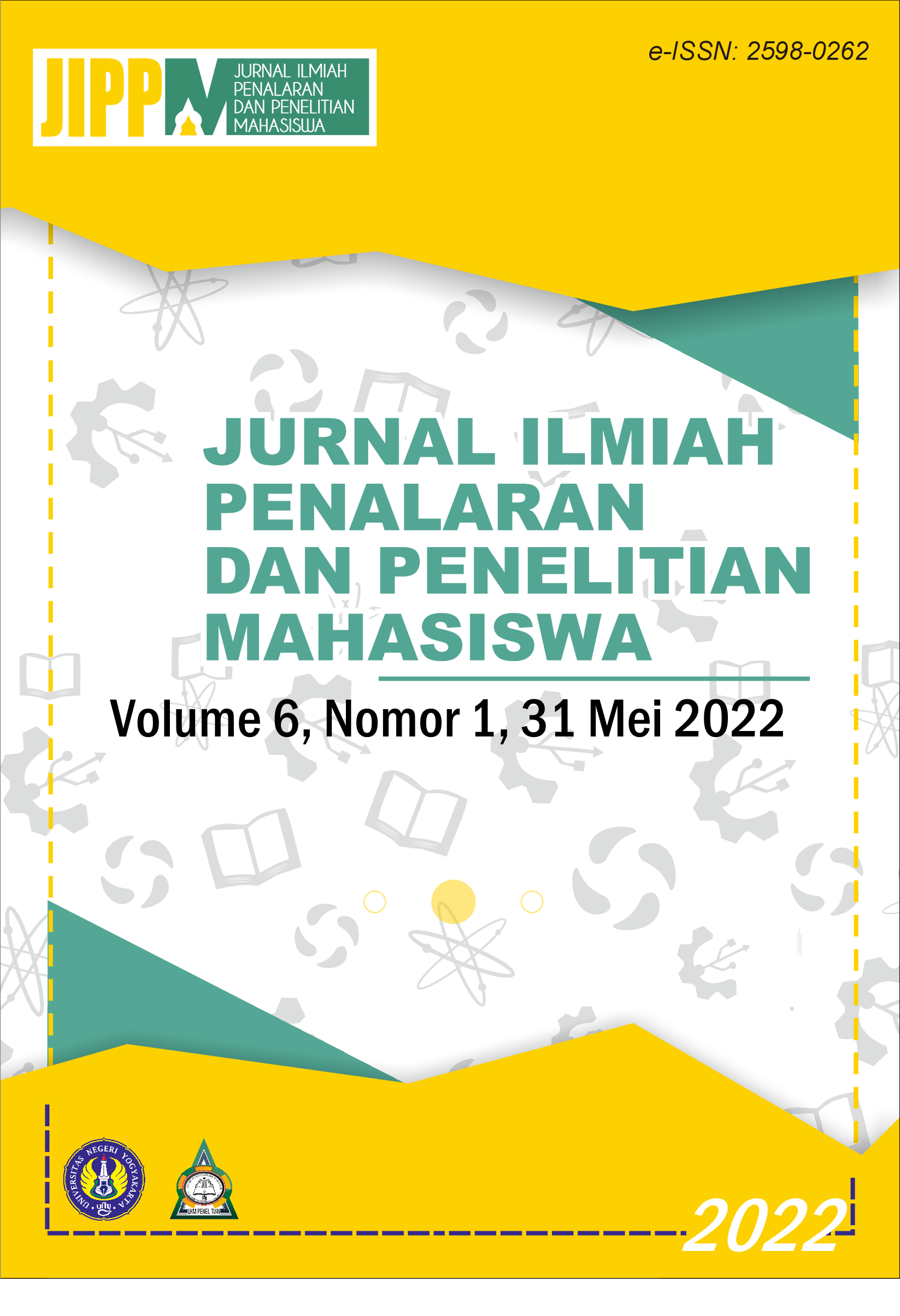PENGOLAHAN LIMBAH KULIT PISANG RAJA (Musa sapientum) MENJADI BIOETHANOL MENGGUNAKAN METODE FERMENTASI DAN DISTILASI
Main Article Content
Abstract
Banana peels are usually just thrown away and become waste, this will certainly
cause environmental problems in a relatively long time. On the other hand, banana
peels contain carbohydrates that will later be processed into bioethanol, especially
plantain peels (Musa sapientum). This study aims to determine the best conditions
for the manufacture of bioethanol made from plantain peel. The method used to
process waste plantain peels into bioethanol is fermentation using Saccharomyces
Cerevisiae yeast, then the fermented products are purified through a distillation
process. The variable observed in this study are ethanol content and ethanol volume
by experimenting with variations in yeast mass during fermentation as much as 10
grams, 20 grams, and 30 grams, fermentation time of 3 days, 5 days, and 7 days,
as well as 15 minutes of distillation time, 30 minutes, and 45 minutes. The results
of this study indicate that the ethanol content is directly proportional to the amount
of yeast mass used, and inversely proportional to the volume produced. The content
is directly proportional to the fermentation time, and inversely proportional to the
volume produce. In the other experiment, ethanol content is not effected by the
distillation time, but produced more volume of ethanol. The best result from this
research was obtained is 145 mL of bioethanol with 5-6 % ethanol content which
came from processing 200 grams of plantain peel which was fermented for 5 days
using 10 grams of yeast and distilled for 45 minutes.
Article Details
References
Jurnal Teknik Kimia, 21(2), 1-7.
Algus, L. L. F. (2014). Isolasi khamir dari tetes tebu (Molase) dan potensinya dalam menghasilkan etanol (Doctoral dissertation, Universitas Islam Negeri
Maulana Malik Ibrahim).
Anhwange, B. A., Ugye, T. J., & Nyiaatagher, T. D. (2009). Chemical composition of Musa sapientum (banana) peels. Electronic Journal of Environmental,
Agricultural and Food Chemistry, 8(6), 437-442.
Anwar, F., & Subagyo, R. (2020). Pembuatan Bioetanol Berbahan Baku Ampas Tebu Dan Kulit Pisang Dengan Variasi Massa Ragi. Jtam Rotary, 2(1), 123-
136.
Ardhiany, Sri. (2019). Pengaruh Penambahan Ragi Terhadap Kadar Alkohol Pada Proses Pembuatan Bioethanol Dari Kulit Pisang. Jurnal Teknik PATRA
Akademika, 10(1), 1-8.
Arif Harton, P. B. (2013). Pelatihan Pemanfaatan Limbah Kulit Pisang SebagaibaHAN DASAR PEMBUATAN KERUPUK. Volume 2(3), 198 - 203.
Arifin, M. (2019). Pemanfaatan limbah nira siwalan (Borassus flabellifer L.) sebagai bahan utama pembuatan bioetanol dengan variasi lama destilasi (Doctoral dissertation, Universitas Islam Negeri Maulana Malik Ibrahim).
Bachruddin, Z. (2018). Teknologi Fermentasi pada Industri Peternakan. UGM PRESS.
Bahri, S., Aji, A., & Yani, F. (2018). Pembuatan Bioetanol dari Kulit Pisang Kepok dengan Cara Fermentasi Menggunakkan Ragi Roti. Jurnal Teknologi Kimia
Unimal, 7(2), 85-100. doi:https://doi.org/10.29103/jtku.v7i2.1252 F.N, N. I., & Aminudin, A. (2019). Pengaruh Waktu Distilasi Etanol-Air Terhadap Konsentrasi Overhead Product dan Bottom Product. CHEESA: Chemical Engineering Research Articles, 2(1), 19-25. doi:http://doi.org/10.25273/cheesa.v2i1.4469
Febrina, R. V., & Nasution, R. S. (2020). PENGARUH MASSA RAGI SACCHAROMYCES CEREVISIAE TERHADAP KADAR BIOETANOL BERBAHAN DASAR LIMBAH KULIT KOPI ARABICA (COFFEA ARABICA L.). AMINA, 2(1), 19-25.
Firdaus, A. K., Qurthobi, A., & R.I.U, A. (2021). Analisa Residu Tape Berbahan Pisang Raja Bulu (musa Paradisiaca L. Var Sapientum). e-Proceeding of Engineering, 8(5), 55-88.
Hartono, A. (2013). PELATIHAN PEMANFAATAN LIMBAH KULIT PISANG SEBAGAIBAHAN DASAR PEMBUATAN KERUPUK. Asian Journal of
Innovation and Entrepreneurship, 2(03), 198-203.
Herlianti, Sefaniyah, & Indri, A. (2018). Pemanfaatan limbah kulit pisang sebagai Bahan Baku pembuatan Bioetanol. Jurnal Teknologi, 6(1), 1-10.
doi:10.31479/jtek.v6i1.1
Khazalina, T. (2020). Saccharomyces cerevisiae in making halal products based on conventional biotechnology and genetic engineering. Journal of halal
product and research (JPHR), 3(2), 88-94.
Martiningsih, E. (2007). Pemanfaatan Kulit Pisang Raja (Musa paradisiaca L. var sapientum) sebagai Substrat Fermentasi Etanol menggunakan
Saccharomyces cerevisiae (Doctoral dissertation, Universitas Muhammadiyah Surakarta).
Musita, N. (2009). Kajian kandungan dan karakteristik pati resisten dari beberapa varietas pisang. Jurnal Teknologi Industri dan Hasil Pertanian, 14(1).
Naufal, A. D. (2019). Pembuatan Bioetanol Secara Fermentasi dari Selulosa yang di isolasi dari Batang Pisang Kepok (Musa Paradisiaca L.) Menggunakan
Ragi Roti (Saccharomyces Cerevisiae).
Pratiwi, R. T. (2018). PENGARUH KONSENTRASI STARTER Saccharomyces cerevisiae DAN WAKTU FERMENTASI UMBI SUWEG (Amorphophallus paeoniifolius (Dennst.) Nicolson) TERHADAP KADAR ALKOHOL DAN UJI NYALA API (FLASH POINT) SEDERHANA SEBAGAI BAHAN BAKAR NABATI (BBN).
Saadah, A. F., Fauzi, A., & Juanda, B. (2017). Peramalan Penyediaan dan Konsumsi Bahan Bakar Minyak Indonesia. Jurnal Ekonomi dan
Pembangunan Indonesia , 17(2), 118-137. doi:http://dx.doi.org/10.21002/jepi.v17i2.661
Safitri, L. (2021). Universitas Muhamadiyah Palembang. Retrieved from http://repository.umpalembang.ac.id/id/eprint/17646/1/122017046_BAB%20I_DAFTAR%20
PUSTAKA.pdf: http://repository.umpalembang.ac.id/id/eprint/17646/1/122017046_BAB%20I_DAFTAR%20PUSTAKA.pdf
Sehwantoro, W., Hindarti, F., & Oktivina, M. (2021). RANCANG BANGUN DAN UJI KINERJA DESTILATOR ELEKTRIK SEBAGAI ALAT DESTILASI
PADA PROSES PEMBUATAN BIOETHANOL. SAINSTECH: JURNAL PENELITIAN DAN PENGKAJIAN SAINS DAN TEKNOLOGI, 31(2), 1-9.
Setiawan, T. (2018). Rancang bangun alat destilasi uap bioetanol dengan bahan baku batang pisang.
Sukriyadi, L. (2010). Kajian Sifat Kimia dan Sifat Organoleptik Pada Tepung Kulit Pisang Dari Beberapa Varietas Pisang (Skripsi). Universitas Khairun
Ternate.
Tejasarwana. (1995). Mikrobiologi Dasar. Jakarta: Erlangga.
Umaiyah, A. S., & Reni, Y. S. (2014). Fermentasi Nira Nipah Skala 50 Liter Menjadi Bioetanol Menggunakan Saccharomyces Cerevisiae.
Wandono, E. H., Kusdiyantini, E., & Hadiyanto, H. (2020). Efektivitas Limbah Kulit Kering Nanas Madu (Ananas Comosus l. Merr) untuk Pembuatan Bioetanol dengan Proses Fermentasi dan Distilasi. Jurnal Energi Baru dan Terbarukan, 1(2), 45-53.
Wusnah, W., Bahri, S., & Hartono, D. (2020). Proses pembuatan bioetanol dari kulit pisang kepok (Musa acuminata BC) secara fermentasi. Jurnal Teknologi
Kimia Unimal, 8(1), 48-56.

